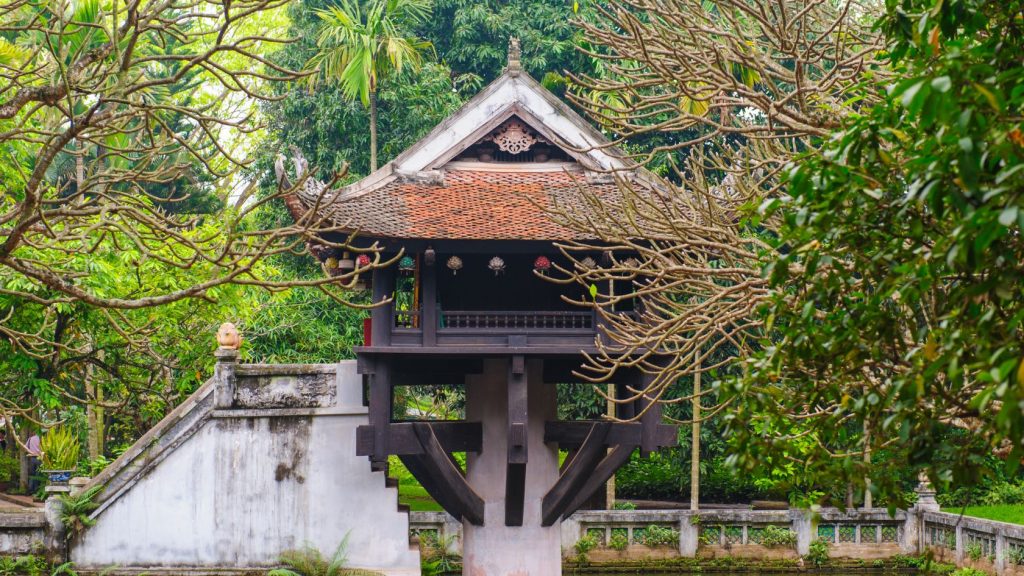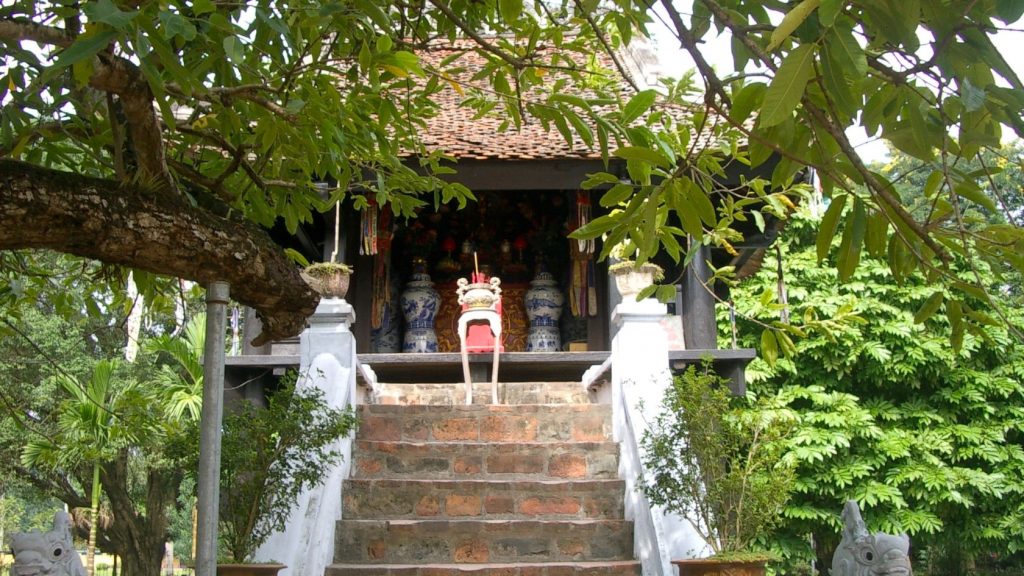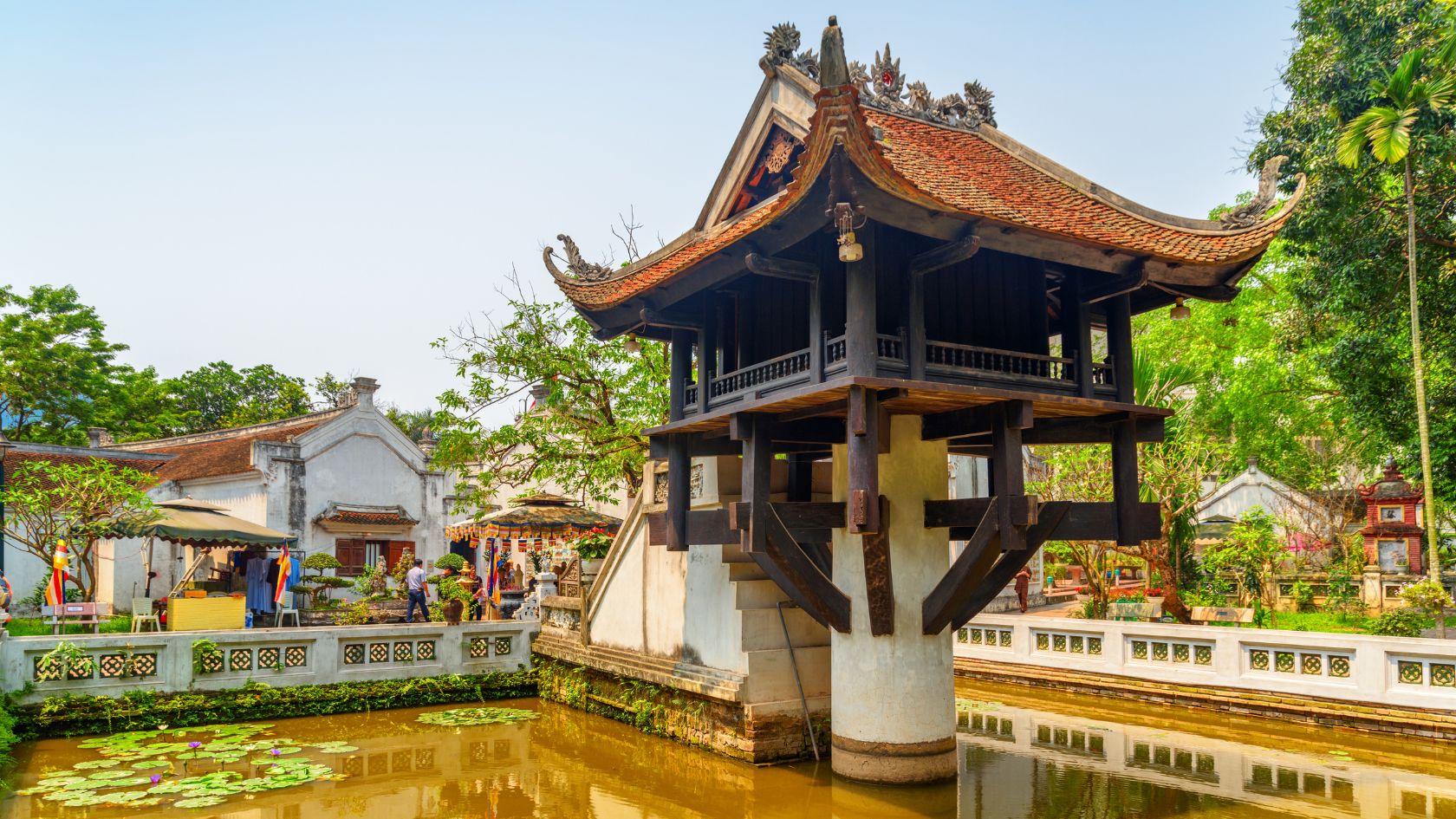Nestled in the heart of Hanoi, the One Pillar Pagoda symbolizes Vietnam’s rich history and unique architectural style. This iconic structure represents Buddhist spiritual ideals and is a testament to the country’s artistic and cultural heritage.
A Glimpse into the Past: One Pillar Pagoda History
The One Pillar Pagoda’s history is as intriguing as its design. Archaeologists have determined that the pagoda was constructed during the Ly Dynasty, particularly between 1028 and 1054. It was commissioned by Emperor Ly Thai Tong, who built the pagoda to honour the female Buddhist goddess Quan The Am Bo Tat. The design is inspired by a lotus flower—an enduring symbol of wisdom and purity in Buddhism and Confucianism—demonstrating the profound influence of religion in Vietnamese culture thousands of years ago.
Despite the ravages of war—most notably in 1954 when invaders bombed the pagoda—it was promptly renovated using designs from the Nguyen Dynasty. Although the current structure may not fully capture its original splendour, it remains a valuable heritage site for its historical significance and cultural resonance.
Architectural Marvel: Exploring One Pillar Pagoda

The One Pillar Pagoda is renowned for its unique and symbolic architecture, inspiring poets and historians alike. Here are some of its most remarkable features:
Lotus Station (Lien Hoa Dai)
At the heart of the pagoda is the Lotus Station, a structure built on a single, elegantly carved stone pillar that appears to rise from a lotus pond. This imagery represents the purity and wisdom of Buddhism and Confucianism. Eight wooden beams support the structure, and the perfectly connected joints ensure its remarkable sturdiness in the middle of Linh Chieu Lake. The roof features an exquisitely carved image of a “double dragon adoring the moon,” while the red bricks with curved corners symbolize the prosperous development of the Vietnamese nation.
Three-Arched Entrance Gate (Tam Quan Gate)
Just in front of the pagoda lies the Tam Quan Gate, a significant entry point that enhances the visitor experience. Originally designed to serve the religious activities of monks, this gate has recently been expanded and renewed to accommodate a growing number of visitors. Its decorative horizontal painting featuring the words “Dien Huu Pagoda” is a testament to the pagoda’s deep cultural roots.
The Stairs Leading to the Main Hall

Visitors must ascend 13 steps—each 1.4 meters wide—to reach the main hall. In Eastern culture, the number 13 symbolizes “fertility and prosperity,” a concept that Emperor Ly Thai Tong specifically intended for this site. The main hall houses a gilded statue of Buddha seated on a lotus, surrounded by offerings of flowers, candles, and fruits, embodying the profound respect for Buddhism.
One Pillar Shiva Temple
Interestingly, the pagoda also incorporates elements reminiscent of a One Pillar Shiva Temple, reflecting the historical synthesis of Buddhist and Hindu traditions in Vietnam. This unique aspect adds to the spiritual and cultural layers of the site, drawing scholars and travelers alike.
How to Reach One Pillar Pagoda
Location
One Pillar Pagoda is located in the park behind Ong Ich Khiem Street, Doi Can Ward, Ba Dinh District—only about 3 kilometres from the centre of Hanoi. Its central location makes it an ideal starting point for exploring other historic landmarks, such as the Ho Chi Minh Mausoleum, Temple of Literature, and Hoan Kiem Lake.
How to Reach One Pillar Pagoda
By Private Car: If you’re travelling by car or motorbike, parking is available at nearby lots on Ngoc Ha Street or Ong Ich Khiem Street.
By Bus: Several bus routes pass through Ba Dinh Square. Look for routes 22, 33, 09, 50, or 45. Get off at the 18A Le Hong Phong bus station for an easy walk to the temple.
By Taxi/Grab: Taxis and Grab are readily available throughout Hanoi. For a direct ride, set your destination to “One Pillar Pagoda, Hanoi.”
Visitor Information
For travellers planning a visit, here are all the essential details about the One Pillar Pagoda.
One Pillar Pagoda Entrance Fee
The One Pillar Pagoda entrance fee is free for Vietnamese citizens and around 25.000 VND for International travellers. It is advisable to check the latest updates, as payments can change. According to the most recent information, visitors can expect to pay a nominal fee to help maintain this historic site.
One Pillar Pagoda Timings
The One Pillar pagoda’s timings are designed to accommodate early birds and those who prefer to visit later in the day. Typically, the pagoda opens early in the morning and closes by sunset, ensuring that visitors can enjoy the peaceful ambience of the site during daylight hours. Exact timings may vary by season, so it is best to verify the current schedule before your visit. Usually the Pagoda is open from 7:00 am to 6:00pm.
One Pillar Pagoda Dress Code
Given its status as a religious and cultural site, the One Pillar Pagoda dress code is modest. Visitors must dress respectfully—avoid wearing sleeveless tops, shorts, or revealing clothing. Comfortable, modest attire is recommended to ensure a pleasant visit and honour the site’s sanctity.
Reviews and Visitor Experiences
A quick look at One Pillar Pagoda reviews reveals that visitors are often enchanted by its serene beauty and unique architectural design. Many praise the pagoda for its historical significance and its tranquil atmosphere amidst the bustling city of Hanoi. Whether you’re a history buff, an architecture enthusiast, or simply looking for a peaceful retreat, the One Pillar Pagoda consistently receives glowing reviews from travellers around the world.
How Different Cities Are Connected
While the One Pillar Pagoda is a key historical site in Hanoi, it also serves as a gateway to exploring other significant cities in Vietnam. Hue, Hoi An, and Ho Chi Minh City have well-established transport networks, often including packages or guided tours connecting these cultural hubs with Hanoi. You can also book bus tickets or use limousine transfers to reach Hanoi from different cities.
